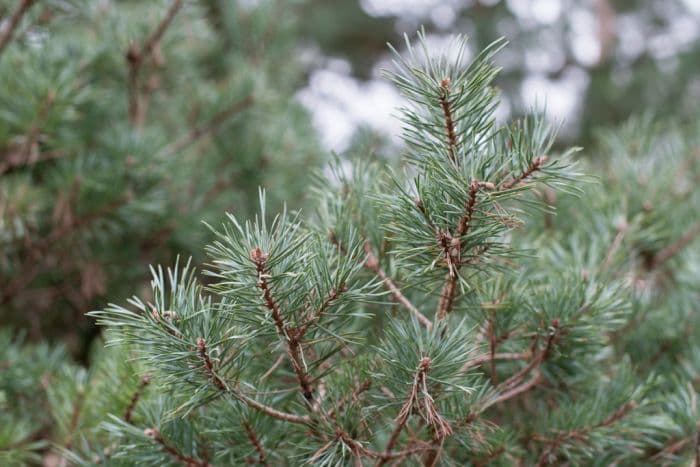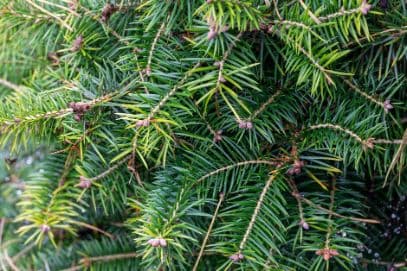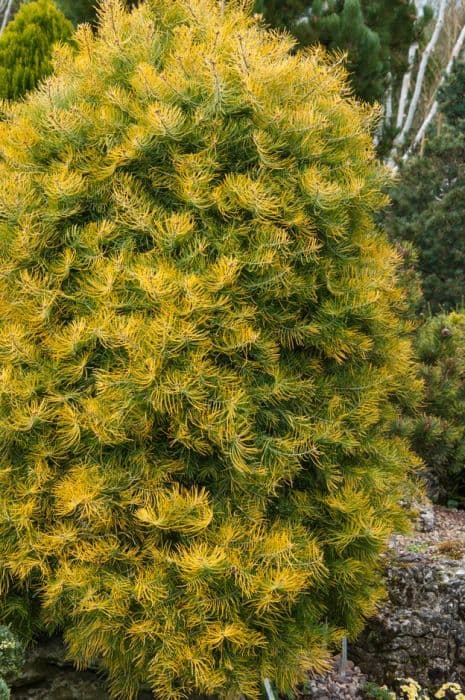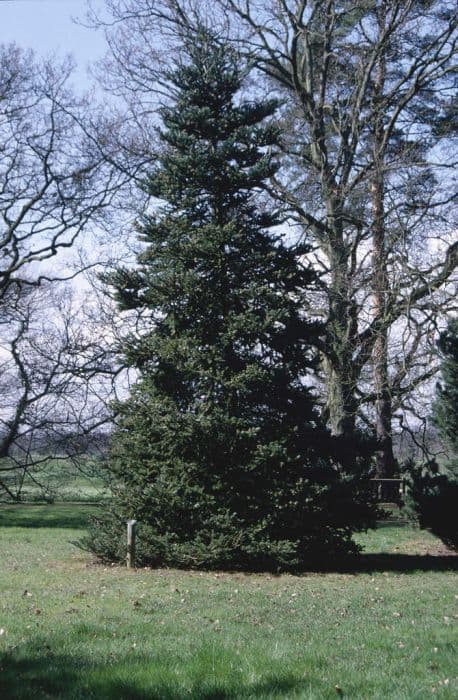Scots Pine Pinus sylvestris 'Frensham'

ABOUT
Pinus sylvestris 'Frensham', commonly known as Scots pine 'Frensham', is a coniferous tree known for its distinctive appearance. This variety of Scots pine has a straight trunk that typically features a flaky and textured bark, which appears in hues of orange-brown, giving it a unique and attractive look. Starting from the base of the trunk, the bark's color and texture can vary, often becoming more rugged and darker with age. The needles of Scots pine 'Frensham' are needle-like in shape, as expected from a pine, and generally present a bluish-green coloration. These needles are gathered in pairs, which creates a dense and bushy look, and they can be quite stiff and sharp to the touch. Branches grow in a somewhat horizontal manner, although they can sometimes be slightly upturned. The overall branch structure gives the pine a well-rounded crown, which contributes to its aesthetic appeal when used in landscaping. On those branches, you would spot the cones, which are the reproductive structures of the Scots pine 'Frensham'. They start out small and green but mature into larger, woody cones that turn brownish as they age. These cones are densely arranged and can persist on the tree for multiple years. Throughout the seasons, Scots pine 'Frensham' remains evergreen, providing color and life to the landscape even during the colder months when other plants may have shed their leaves. Its resilience and characteristic look with textured bark and vibrant foliage make it a favored choice for gardens where a hardy yet visually appealing tree is desired.
About this plant
 Names
NamesFamily
Pinaceae
Synonyms
Frensham Scots Pine, Frensham Pine
Common names
Pinus sylvestris 'Frensham'.
 Characteristics
CharacteristicsLife cycle
Perennials
Foliage type
Evergreen
Color of leaves
Green
Height
20-60 feet (6-18 meters)
Spread
20-30 feet (6-9 meters)
Plant type
Tree
Hardiness zones
3-7
Native area
Europe
Benefits
 General Benefits
General Benefits- Attractive Aesthetic: Scots Pine is known for its distinctive orange-red bark and conical shape, adding visual interest to the landscape.
- Shade Provider: Its dense foliage can create a cool, shaded area, providing relief on sunny days.
- Erosion Control: The extensive root system helps stabilize soil and prevent erosion on slopes.
- Wildlife Habitat: Offers shelter and nesting sites for birds and other wildlife.
- Drought Resistance: Once established, it is tolerant to dry conditions, making it suitable for xeriscaping.
- Windbreak: Can be used in rows to protect against wind, reducing soil desiccation and providing shelter for other plants.
- Adaptability: Scots Pine can thrive in a wide range of soil types and climatic conditions.
- Seasonal Interest: Provides year-round greenery and seasonal changes, such as cones and vibrant bark colors.
- Low Maintenance: Requires minimal care once established, making it a convenient choice for many landscapes.
 Medical Properties
Medical Properties- Antiseptic: Scots pine (the common name of Pinus sylvestris) has been traditionally used for its antiseptic properties, particularly the resin and essential oil derived from the tree.
- Respiratory aid: The needles of Scots pine have been used in inhalations to alleviate symptoms of respiratory conditions due to their expectorant properties.
- Anti-inflammatory: Scots pine products may have anti-inflammatory effects, useful in treating conditions like arthritis and muscle pains.
- Antimicrobial: Extracts of Scots pine have shown antimicrobial activity, which may help in the healing of minor wounds and preventing infections.
 Air-purifying Qualities
Air-purifying QualitiesThis plant is not specifically known for air purifying qualities.
 Other Uses
Other Uses- Scots pine wood shavings can be used as a natural stuffing for traditional teddy bears, giving them a pleasant, subtle pine scent.
- The resin from Scots pine can be used as a flux in soldering metals, aiding the flow of solder and improving joint quality.
- Scots pine needles can be woven or knit into baskets and mats, taking advantage of their length and pliability after soaking.
- The bark of Scots pine can be used for tanning leather, providing a source of tannin that lends a unique color and finish to the leather.
- Dried Scots pine cones can serve as natural fire starters, their sap content enabling them to burn readily and assist in lighting campfires or wood stoves.
- Scots pine sap can be used to create a natural adhesive or glue for emergency repairs, especially in outdoor and survival situations.
- Thick layers of Scots pine branches can be used as a natural insulation material in eco-friendly building practices.
- Carving craftspeople may use Scots pine wood for making intricate sculptures or folk art, as it is relatively easy to carve yet holds detail well.
- The strong, straight trunks of Scots pine trees can be used as natural posts or masts in rustic building or sailing applications.
- Scots pine sawdust can be added to compost heaps as a carbon-rich agent, helping to balance the compost and improve its overall quality.
Interesting Facts
 Feng Shui
Feng ShuiThe Scots Pine is not used in Feng Shui practice.
 Zodiac Sign Compitability
Zodiac Sign CompitabilityThe Scots Pine is not used in astrology practice.
 Plant Symbolism
Plant Symbolism- Longevity: Pinus sylvestris, commonly known as Scots Pine, is a species that can live for a considerable amount of time, with some specimens reaching several hundreds of years in age. This durability makes the tree symbolic of longevity and eternal life.
- Resilience: Scots Pines are able to thrive in challenging environments, often growing in poor soils and withstanding cold temperatures. This resilience makes them a symbol of perseverance and tenacity.
- Strength: The wood of the Scots Pine is strong and sturdy, used historically in construction and shipbuilding. This attribute leads to the tree representing strength and stability.
- Wisdom: In various cultures, pine trees are often associated with wisdom and knowledge, due to their long lifespans and their timeless presence in forests.
- Peace: The evergreen nature of the Scots Pine, continuously holding its needles throughout the seasons, provides a sense of calm and tranquility, symbolizing peace and serenity.
- Purity: In some traditions, the pine tree is seen as a symbol of purity, perhaps connected to its aromatic scent and the cleanliness of its appearance amidst snowy landscapes.
- Health: The fresh, clean scent of pine and its various uses in traditional medicine have also made it symbolic of health and vitality.
- Nobility: Pines are frequently associated with nobility and high moral standards, standing tall and upright against the elements.
 Water
WaterScots Pine 'Frensham' requires watering that keeps its soil consistently moist but not waterlogged. During the first growing season, water the plant deeply once a week with about 10-15 gallons depending on weather conditions; consistently moist soil is key for young trees. Once established, Scots Pine are drought-tolerant and may require less frequent watering, depending on your climate and soil conditions; however, during prolonged dry spells, a deep watering every two to four weeks may be necessary. Adjust the amount and frequency of watering based on weather conditions, season, and soil moisture.
 Light
LightScots Pine 'Frensham' thrives in full sun, meaning it needs at least six hours of direct, unfiltered sunlight each day. The best spot for this pine is in an open area where it can receive ample sunlight from above, ensuring healthy growth and development. Avoid planting in shaded areas, as insufficient light can lead to poor needle color and weak growth.
 Temperature
TemperatureScots Pine 'Frensham' can tolerate a wide range of temperatures and is hardy from USDA zones 3 to 7. It can withstand minimum temperatures of down to -40°F and can cope with high temperatures well into the 90°F range, making it adaptable to many climates. However, its ideal growing conditions are in regions where the temperature rarely exceeds 75°F, as cooler climates tend to be more conducive to its health and longevity.
 Pruning
PruningScots Pine 'Frensham' should be pruned to remove dead or damaged branches, encourage a strong form, and maintain its overall health. Pruning is best done during the dormant season, in late winter or early spring before new growth starts. This species does not require frequent pruning, so aim to prune every few years or as needed to remove any problematic branches. It’s also important to maintain a central leader and avoid removing too many of the lower branches to preserve the tree's natural shape.
 Cleaning
CleaningNot needed
 Soil
SoilThe Scots Pine 'Frensham' prefers well-drained, sandy loam soil with a pH range of 5.5 to 7.0 for optimal growth. A mix of one-third peat, one-third sand, and one-third garden soil can work well. Adding some pine bark can improve drainage and mimic the plant's natural environment.
 Repotting
RepottingScots Pine 'Frensham' does not require frequent repotting. It can be repotted every 2-3 years or when the root system outgrows the current container. Younger trees may need repotting more often than mature ones.
 Humidity & Misting
Humidity & MistingScots Pine 'Frensham' is adaptable and does not require high humidity, making it suitable for average outdoor conditions. It thrives best with natural rainfall and ambient outdoor humidity levels.
 Suitable locations
Suitable locationsIndoor
Ensure bright light, well-draining soil, and infrequent watering.
Outdoor
Plant in sun, amend soil for drainage, water regularly till established.
Hardiness zone
3-7 USDA
 Life cycle
Life cycleThe life of Pinus sylvestris 'Frensham', commonly known as Scots Pine 'Frensham', begins with seed germination, typically occurring in spring under suitable conditions of moisture and temperature. The seedlings develop a root system and shoot, eventually growing into a young sapling with characteristic needles and a developing woody stem. As the tree matures, it undergoes a period of vegetative growth, expanding in height and girth, with the crown becoming more developed and dense. Scots Pine 'Frensham' reaches reproductive maturity several years after germination, producing male cones that release pollen and female cones that, after pollination, develop seeds. The mature tree then enters a long phase of adult life, where it can produce cones yearly and stands resilient against environmental stresses. Eventually, the tree reaches old age, its growth slows, and it succumbs to natural cycles, completing its life span, with its seeds carrying on the lineage.
 Propogation
PropogationPropogation time
Spring-Early Summer
The most popular method of propagating the Scots Pine, specifically the Pinus sylvestris 'Frensham', is through seed collection and sowing. The best time for sowing seeds is generally in the spring, after the threat of frost has passed to ensure that the seedlings are not damaged by cold temperatures. The seeds should be collected from cones that have started to open, indicating that they are mature. These seeds are typically sown in well-draining soil and lightly covered with a thin layer of the same soil. It's important to keep the soil moist but not waterlogged, as Scots Pine seeds require a consistent level of moisture to germinate effectively. Once seedlings have developed to a robust size and have a few sets of true leaves, they can be transplanted into individual pots or into a prepared area of the garden. The process from sowing to germinating can take several weeks, and growers should be patient as the seedlings establish themselves.









